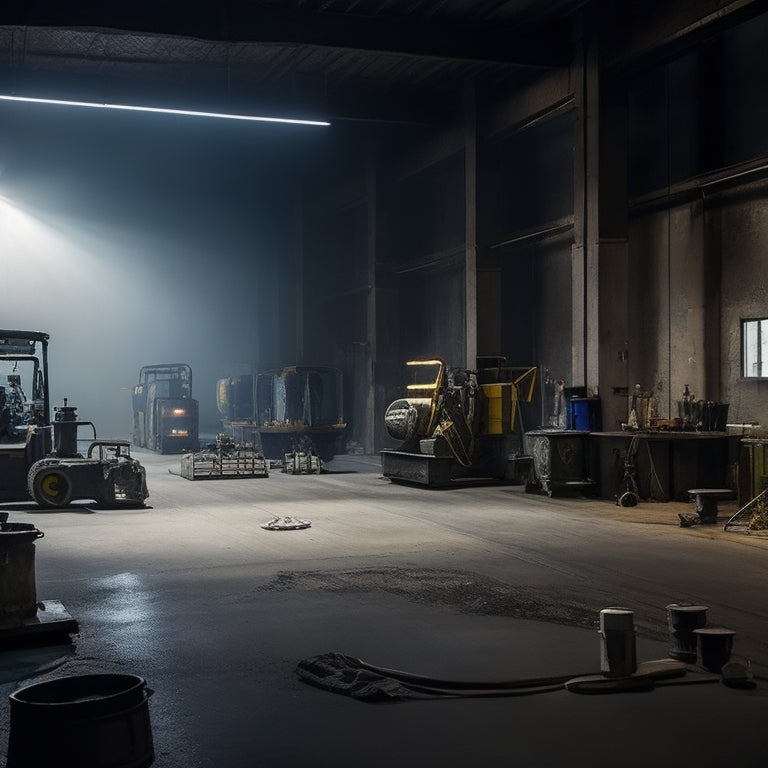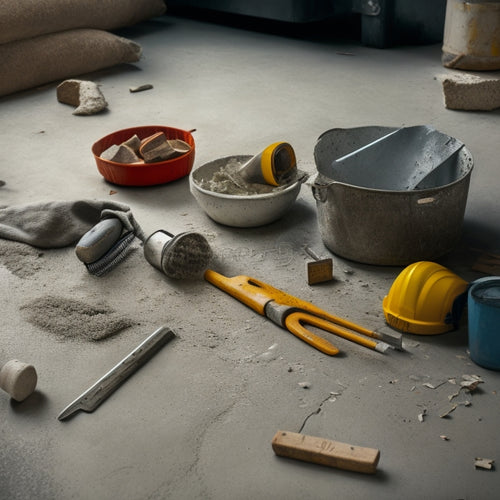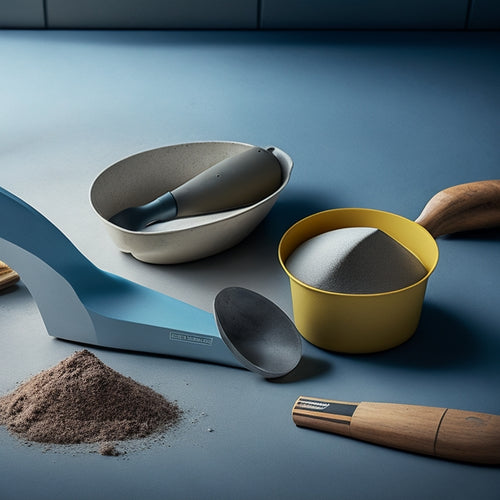
Top Tools for Commercial Concrete Grinding Projects
Share
When tackling commercial concrete grinding projects, you'll need a range of top tools to get the job done efficiently. For surface preparation, consider grinders, scarifiers, and shot blasters, each designed for specific tasks like removing old adhesives or aggressive cleaning. Edgers and sanders help achieve defined cuts and smooth finishes, while polishers refine surfaces to a high shine. Don't forget dust collectors for safe operation and measuring tools for precise cuts. With the right tools in your arsenal, you'll be well-equipped to handle any commercial concrete grinding project that comes your way - and with the right techniques, you'll be able to take your projects to the next level.
Key Takeaways
• Surface preparation tools, including grinders, scarifiers, and shot blasters, are essential for removing old coatings and achieving a smooth surface.
• Finishing tools, such as edgers, sanders, and polishers, help deliver high-quality outcomes with defined cuts, smooth finishes, and high-gloss results.
• Dust collectors are crucial for safe operation, capturing airborne particles and minimizing health risks associated with concrete dust.
• Measuring tools, including digital calipers and laser levels, ensure precise cuts and measurements in commercial concrete grinding projects.
• Mastering techniques, such as blast pattern control and surface preparation speed, is vital for efficient task completion and staying within budget.
Grinders for Surface Preparation
When preparing a concrete surface for coatings, toppings, or overlays, you'll need grinders specifically designed for surface preparation to effectively remove old adhesives, sealers, or existing coatings. These grinders are designed to handle the rough, uneven texture of concrete, and their specialized features make them ideal for surface preparation.
To achieve optimal results, you'll need to master concrete grinding techniques, including adjusting the grinder's speed and pressure to suit the surface condition. Proper equipment maintenance is also essential, as it guarantees the grinder remains in good working condition and prevents damage to the surface.
Regular maintenance tasks include cleaning the grinder, checking and replacing worn-out parts, and lubricating moving components. By following these guidelines, you'll be able to effectively remove old coatings and prepare the surface for the next step in the process.
With the right grinder and techniques, you'll achieve a smooth, even surface that's ready for coatings, toppings, or overlays. By investing time in equipment maintenance and mastering concrete grinding techniques, you'll secure a successful outcome for your commercial concrete grinding project.
Edgers for Defined Cuts
Edgers for Defined Cuts
For defined cuts and precise edge work, you'll need to employ edgers specifically designed for concrete grinding, which can navigate tight spaces and corners with ease. These specialized tools enable you to achieve accurate cuts and maintain control in confined areas. To master edger techniques, it is crucial to select the right edger for your specific project requirements.
Here's a comparison of popular edger options:
| Edger Type | Cut Accuracy | Weight |
|---|---|---|
| Electric Edger | High | 15-20 lbs |
| Gas-Powered Edger | Very High | 25-30 lbs |
| Walk-Behind Edger | High | 40-50 lbs |
| Ride-On Edger | Extremely High | 100-150 lbs |
When choosing an edger, consider factors such as cut accuracy, weight, and maneuverability. By selecting the right edger for your project, you'll be able to achieve precise cuts and maintain control, even in tight spaces. By mastering edger techniques and selecting the ideal tool, you'll be able to deliver high-quality results and take your concrete grinding projects to the next level.
Sanders for Smooth Finishes
When you're looking to achieve a high-gloss finish or remove imperfections from your concrete surface, you'll turn to sanders as your go-to tools.
These machines are designed to polish concrete floors to a mirror-like finish, and their abrasive pads make quick work of removing scratches and blemishes.
Polish Concrete Floors
You can achieve a high-gloss, smooth finish on your concrete floors by using specialized sanders and polishers that progressively refine the surface to a desired level of reflectivity. These machines utilize a series of abrasives, from coarse to fine, to remove imperfections and reveal a glossy, mirror-like finish.
The benefits of polishing concrete floors are numerous, including increased durability, resistance to stains, and ease of maintenance. By polishing your concrete floors, you'll also reduce the need for frequent cleaning and waxing, as the glossy surface is less prone to dirt and grime accumulation.
To maintain your polished concrete floors, it's crucial to follow some simple tips. Regularly sweep or vacuum the floor to remove debris, and mop with a neutral cleaner to prevent etching. Avoid using acidic substances or harsh chemicals, as they can dull the finish.
Additionally, consider applying a topical sealant to protect the floor from stains and spills. By following these maintenance tips, you'll be able to enjoy your polished concrete floors for years to come.
Remove Imperfections Easily
With the right sander, imperfections in the concrete surface are quickly and easily removed, paving the way for a smooth finish.
You'll be able to tackle surface irregularities like unevenness, cracks, and pitting, achieving a uniform base for further polishing or coating. When it comes to imperfection removal, a high-quality sander is essential. Look for a model with adjustable handlebars, a robust motor, and a dust-collection system to minimize mess and maximize efficiency.
For surface restoration, you'll want a sander that can handle aggressive removal of old coatings, adhesives, or damaged concrete. A walk-behind sander or a ride-on model will provide the necessary power and control to get the job done.
Don't forget to choose the right abrasives for your specific task, as this will greatly impact the effectiveness of your sander. By selecting the right tool and abrasives, you'll be able to remove imperfections easily and efficiently, setting yourself up for a successful concrete grinding project.
Polishers for High Shine
Achieving a high-shine finish on concrete surfaces requires specialized polishers designed to progressively refine the surface, ultimately producing a mirror-like reflection. You'll need high speed polishers that can efficiently remove scratches and imperfections, preparing the surface for the final polishing stages. These machines typically operate at speeds between 1,000 to 2,000 RPM, allowing for rapid material removal and refinement.
When it comes to polishing, you'll rely on diamond polishing pads to progressively refine the surface. These pads come in a range of grits, from coarse to fine, and are designed to work in sequence to achieve the desired level of shine.
By starting with a coarse grit and working your way up to finer grits, you can achieve a high-shine finish that meets your project's requirements. It's crucial to choose the right polishing pads for your specific project, as they can greatly impact the final result.
With the right high speed polisher and diamond polishing pads, you'll be able to achieve a showroom-quality finish that exceeds your clients' expectations.
Scarifiers for Heavy Removal
Scarifiers, designed for aggressive material removal, are the go-to tools when faced with heavily damaged or deteriorated concrete surfaces that require extensive repair.
You'll find that there are several scarifier types, each suited for specific tasks. Drum scarifiers, for instance, are ideal for removing thick coatings or scarifying large areas, while rotary scarifiers excel at removing thin coatings and performing fine-texturing work. When choosing a scarifier, consider the type of concrete, the level of damage, and the desired finish.
To guarantee peak performance and extend the life of your scarifier, regular maintenance is essential. You should regularly inspect and replace worn or damaged cutting tools, as well as clean the machine to prevent debris buildup.
Additionally, lubricate moving parts and check the scarifier's belt tension to prevent premature wear. By selecting the right scarifier for the job and keeping it well-maintained, you'll be able to efficiently remove heavy coatings, repair cracks, and prepare surfaces for further treatment.
Shot Blasters for Aggressive Cleaning
When you're tackling aggressive cleaning jobs with shot blasters, you'll want to focus on two key performance factors: blast pattern control and surface preparation speed.
You need to be able to direct the blast precisely to remove contaminants and old coatings efficiently.
Blast Pattern Control
By adjusting the blast pattern on your shot blaster, you can optimize the aggressive cleaning process to effectively remove heavy coatings, old adhesives, or thick layers of dirt and grime from concrete surfaces. This is essential in commercial concrete grinding projects, where efficient removal of contaminants is key to achieving a smooth finish.
To achieve effective blasting, you'll need to master blast pattern techniques that guarantee consistent coverage and minimize overlap. One technique is to divide the surface into sections, blasting each one in a consistent pattern. This helps maintain even pressure and prevents re-blasting the same area, which can lead to damage or unevenness.
You can also adjust the blast pattern to accommodate different surface types, such as rough or smooth concrete. By controlling the blast pattern, you'll be able to remove contaminants quickly and efficiently, saving time and resources in the long run.
Surface Preparation Speed
You'll maximize surface preparation speed by selecting the right shot blaster and optimizing its settings to tackle aggressive cleaning tasks on commercial concrete grinding projects. Shot blasters are ideal for removing heavy coatings, adhesives, and other stubborn substances from concrete surfaces. By choosing a shot blaster that matches the job requirements, you'll guarantee efficient removal of unwanted materials, reducing the time spent on surface preparation.
To further boost efficiency, focus on optimizing shot blaster settings. Adjust the blast pattern, shot size, and air pressure to suit the specific project needs. This will help you achieve the desired level of cleanliness while minimizing waste and reducing the risk of surface damage.
Implementing these efficiency techniques will have a direct impact on your project timelines, allowing you to complete tasks faster and move on to the next stage of the project. By streamlining surface preparation, you'll be able to meet deadlines and stay within budget.
With the right shot blaster and optimized settings, you'll be able to tackle even the most aggressive cleaning tasks with confidence and precision.
Dust Collectors for Safe Operation
Dust collectors play a vital role in guaranteeing safe operation of commercial concrete grinding tools by capturing airborne particles that can pose serious health risks to operators and bystanders.
Concrete grinding generates a significant amount of dust, which can lead to respiratory problems and other health hazards if not controlled. Effective dust control is essential to minimizing these risks. That's where dust collectors come in - they're designed to capture 99% of dust particles, guaranteeing a cleaner and safer working environment.
When selecting a dust collector for your commercial concrete grinding project, you should consider factors such as airflow, filtration efficiency, and mobility. Look for units with high airflow rates to efficiently capture dust particles, and those with HEPA filters that can capture 99.97% of particles as small as 0.3 microns.
Additionally, consider dust collectors with wheels or casters for easy movement around the job site. By investing in a high-quality dust collector, you can guarantee a safe and healthy work environment for you and your team.
Measuring Tools for Precise Cuts
Accurate measurements are vital to achieving precise cuts with commercial concrete grinding tools, and using the right measuring tools can make all the difference. When it comes to measuring tools, you'll need ones that provide high measurement accuracy to guarantee precise cuts.
A digital caliper is a must-have for measuring the width and depth of cuts, as well as the thickness of materials. Make sure to choose a caliper with high precision, typically 0.001 inches or 0.01 mm.
To maintain measurement accuracy, it's important to calibrate your measuring tools regularly. Calibration techniques may vary depending on the tool, so be sure to follow the manufacturer's instructions.
Additionally, consider using a laser level to make certain your measurements are straight and level. This is particularly important when working on large commercial projects where accuracy is paramount.
Frequently Asked Questions
Can I Use a Grinder for Both Concrete and Stone Surfaces?
You can utilize a grinder for both concrete and stone surfaces if it's designed for versatility, ensuring surface compatibility. Check the grinder's specifications to confirm its ability to handle varied materials and prevent damage or ineffective results.
What Safety Gear Is Required for Operating a Shot Blaster?
When operating a shot blaster, you'll need essential safety gear, including a respirator, safety glasses, ear protection, gloves, and a dust mask to prevent inhalation of airborne particles, ensuring your protection from hazardous debris and dust.
How Often Should I Replace the Diamond Blades on My Grinder?
You should replace your diamond blades every 3-6 months or when worn, as excessive wear reduces grinder efficiency and increases risk of damage. Regularly inspecting and maintaining your blades guarantees peak performance and extends diamond blade lifespan.
Are Dust Collectors Necessary for Small-Scale Concrete Projects?
Did you know that 99% of airborne dust particles are under 10 microns, making them invisible and hazardous? When tackling small-scale concrete projects, you're risking health risks without proper dust control, making dust collectors a necessary investment for your well-being.
Can I Rent Concrete Grinding Equipment for a One-Time Project?
You can rent concrete grinding equipment for a one-time project, which can help reduce project costs by eliminating the need for equipment purchase and maintenance; explore rental options to find the best fit for your specific needs.
Conclusion
As you wrap up your commercial concrete grinding project, remember that having the right tools is vital for success.
With the top tools outlined above, you'll be well-equipped to tackle any concrete grinding task.
Consider this: the global concrete grinding market is projected to reach $2.5 billion by 2025, with a growth rate of 5.5% annually.
This statistic highlights the increasing demand for high-quality concrete grinding services, making it essential to stay ahead of the curve with the right tools and expertise.
Related Posts
-

Top 10 Concrete Repair Tools for Small Fixes
You'll need the right tools to tackle small concrete repairs efficiently and effectively. When it comes to small fixe...
-

Concrete Foundation Building Tools for Homeowners' Success
As you start your concrete foundation building project, it is vital to have the right tools to guarantee success. You...
-

Ergonomic Concrete Tools for Tight Spaces
When you're tackling concrete work in tight spaces, ergonomic tools are your best bet for comfort and efficiency. The...


